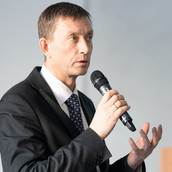Carbon Supersites: Paving the Way for Achieving National Carbon Neutrality
Victor Valdayskikh, head of the Ural-Carbon supersite, explained how carbon supersites can contribute to Russia’s carbon neutrality. He also explained why businesses need climate projects and where the country’s first greenhouse gas emission quotas are located. He talked about this and much more during his speech at the 3rd seminar of the Ural-Carbon School at the Ural Federal University.
“The presidential decree on reducing greenhouse gas emissions provides for the country to become carbon neutral by 2060, i.e. the country as a whole will not emit any climate-active gases into the atmosphere. It will not be possible to achieve carbon neutrality in Russia by reducing emissions alone. The approach to carbon neutrality will be achieved through the implementation of climate projects – including the Carbon Supersites project – and the application of a refined methodology of absorption capacity,” explains Victor Valdayskikh.
The implementation of climate projects makes it possible to enter carbon markets, the biologist adds. Russia currently has two national mechanisms for regulating the market of carbon units to achieve decarbonization goals: the compliance market (experiment with quotas on Sakhalin) and the voluntary carbon market. Both markets have been implemented at the legislative level. The Registry of Carbon Units has also been set up, in which eight climate projects are registered.
“There are currently only eight climate projects registered in the Russian Federation. In reality, there are many more in Russia, but they are either in the process of registration or registered on international markets. Dozens of large companies and corporations have made certain commitments to reduce greenhouse gas emissions,” says Victor Valdayskikh.
Russia is using a variety of mechanisms to decarbonize its economy, including incentives and fines. One of the new measures is the introduction of greenhouse gas emission quotas in Sakhalin, for exceeding which a thousand rubles per ton of CO2 equivalent will be charged. According to Valdayskikh, after the experiment is tested, it will be extended to all regions of the country.
“As part of the Sakhalin experiment, companies are given certain quotas for greenhouse gas emissions. They have to meet these quotas, and if they do not meet them, they have to replace them with carbon units, which are created, among other things, as a result of implementing climate projects. In other words, they either have to meet these quotas, get their carbon units, or buy them. Of course, the Sakhalin experiment will go beyond the limits of the experiment and sooner or later will be extended to the whole country,” Victor Valdayskikh believes.
In February 2021, the Russian Ministry of Science and Higher Education launched a pilot project to create carbon supersites in the country’s regions for the development and testing of carbon balance control technologies. On July 16, 2021, the program of the Ural-Carbon supersite in the Sverdlovsk region was approved. The project will be officially launched in the fall of 2021. The Ural-Carbon supersite is represented by the taiga forests, as the forest area makes up 70 percent of the territory of the Sverdlovsk region. The taiga is one of the most important reservoirs of carbon from the atmosphere due to photosynthesis and its long-term storage. The research sites are the Kourovka Astronomical Observatory of the UrFU and the Ural Educational and Experimental Forestry of the Ural State Forest Engineering University. The Ural State Agricultural University, the Ural State Mining University, the Institute of Plant and Animal Ecology of the Ural Branch of the Russian Academy of Sciences, the Institute of Industrial Ecology (UB RAS), the Institute of Mathematics and Mechanics (UB RAS), and the Botanical Garden (UB RAS) are also involved in the project.

